With indications that the economy in Europe bottomed out in mid-2013, corporate results improved. The United States continued to register signs of recovery, characterized by improvement in the employment environment and an increase in personal consumption. In Japan, corporate performance took a favorable turn, especially for exporters benefitting from continuing yen weakness, and capital investment increased steadily. In contrast, conditions in emerging countries remained challenging in Asia, Latin America and elsewhere as economic growth slowed.
Net Sales
In the fiscal year ended March 31, 2014, net sales rose 16.1% year on year to ¥943.7 billion, due largely to the effect of exchange rates resulting from the persistent weakness of the yen, increased sales of main products in the Business Technologies Business, improvement to the product mix and the effect of acquisitions.
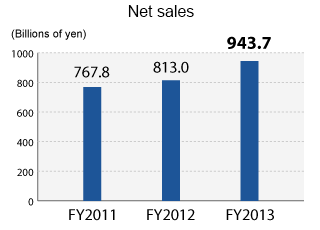
Operating Income
Operating income rose to ¥58.1 billion, an increase of 43.0% year on year. Although profit was down in the Industrial Business, sales growth in the Business Technologies Business and measures to reduce costs contributed to this significant increase.
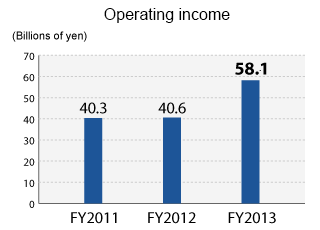
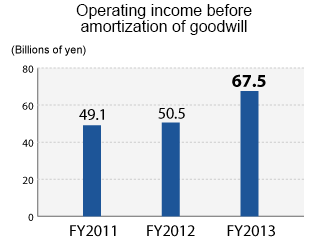
Income before Income Taxes and Minority Interests
Income before income taxes and minority interests fell 30.5% year on year to ¥23.5 billion, due primarily to a loss on withdrawal from the business of glass substrates for HDDs and an impairment loss on structures associated with the termination of the Group's production of film for the Healthcare Business.
Net Income
Net income increased 44.5% year on year to ¥21.8 billion, due in part to tax effects related to the revision of deferred tax assets in line with reorganization of the Group's administrative structure implemented in April 2013.
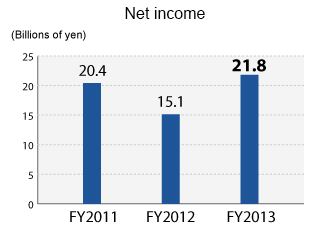
Business Technologies Business
In the office field, sales of A3 color MFPs remained strong and sales volumes increased significantly compared with the previous fiscal year in all regions, including Japan, the United States and Europe. The increasing share of high-end models contributed to sales expansion. In Optimized Print Services (OPS), we strengthened our global business structure, further expanded the service menu, and reinforced business-generating and proposal-making capabilities, thereby steadily securing more customers and expanding the operating base. Furthermore, we established a hybrid-type sales model for small- and medium-sized companies in Europe and the United States that combines IT business solution services with MFPs. By doing so, we cultivated new customers, expanded the scale of projects and realized added value.
In the production print field, sales volumes of color units and monochrome units grew year on year. In addition, we expanded operations related to high-mix, small-lot on-demand print services as well as production and print services for sales promotion materials through Kinko’s Japan Co., Ltd. and Charterhouse Print Management Limited (headquartered in the UK), both of which were acquired in the previous fiscal year. As a result, we are providing a wider range of options to meet customers’ printing needs. In Europe, we formed a capital and business alliance with France-based MGI Digital Graphic Technology S.A., which operates a unique business in such growth markets as plastic cards. This alliance is aimed at developing applications for package printing, in addition to paper output in the existing commercial printing market.
As a result, net sales to external customers in the Business Technologies Business climbed 25.5% year on year to ¥729.8 billion and segment profit soared 101.8% to ¥63.8 billion. The increase in net sales was attributable to the effect of the steadily weak yen on foreign exchange rates, sales growth of mainstay color units, improved product mix and acquisitions. The considerable jump in segment profit was due to an increase in gross profit resulting from sales expansion, the effect of foreign exchange rates, and the full year impact of measures to reduce production costs. These cost reductions included decreasing fixed costs by promoting production reform and unit procurement in the production division, conducting centralized purchasing of raw materials and digital components, and implementing value engineering.
Industrial Business
In the display materials field, sales volumes of plain TAC films for LCD polarizers and VA-TAC films for increasing the viewing angle both decreased compared with the previous fiscal year due to deterioration in the market for notebook PCs, adjustments to inventories of components and materials used for TVs and diversification.
In the measuring instruments field, the acquisition of Instrument Systems GmbH (headquartered in Germany) contributed to increased sales and profit. In the optical products field, sales of pickup lenses for Blu-ray Discs used in video game consoles and lenses for large projectors were strong, but sales of lenses for cameras fell on weak demand.
As a result, net sales to external customers in the Industrial Business decreased 20.9% year on year to ¥116.1 billion and segment profit fell 36.0% to ¥15.1 billion.
Healthcare Business
In the Healthcare Business, sales of the cassette-type digital radiography system AeroDR remained solid with sales volume growth in Japan and the United States and a steady increase in completed deliveries to large-scale medical institutions. We have gradually increased the number of projects we are engaged in based on the collaboration we have been promoting with leading sales partners in Europe and the United States. Sales of film products in emerging countries grew, with overall sales surpassing those of the previous fiscal year.
Furthermore, making use of the resources gained following the transfer of the business from Panasonic Healthcare Co., Ltd., we established an integrated system for ultrasound diagnostic imaging equipment, spanning from development to production and sales. This field is positioned as a new growth driver. In the fiscal year under review, we pushed ahead with preparations for full-fledged business development.
As a result, net sales to external customers in the Healthcare Business climbed 13.2% year on year to ¥82.3 billion and segment profit rose 34.4% to ¥4.5 billion.
Cash Flows from Operating Activities
Net cash provided by operating activities amounted to ¥89.9 billion, up from ¥66.4 billion in the previous fiscal year. Positive factors included income before income taxes and minority interests of ¥23.5 billion, depreciation and amortization of ¥47.3 billion, impairment loss of ¥17.4 billion, and amortization of goodwill of ¥9.4 billion. These were partially offset by outflows including a ¥0.8 billion decrease in working capital and a ¥13.7 billion payment for income taxes.
Cash Flows from Investing Activities
Net cash used in investing activities totaled ¥55.7 billion, an improvement from ¥63.4 billion used in the previous fiscal year. Cash of ¥36.4 billion was used in the acquisition of property, plant and equipment, primarily for capital investment in the Business Technologies Business, new business investments in the Industrial Business and the construction of a new R&D building. Other cash outflows included ¥8.6 billion for the purchase of intangible assets, ¥6.1 billion associated with payments and purchases of investments in subsidiaries and businesses, and ¥4.9 billion for acquisition of investment securities.
As a result, free cash flow, calculated as the sum of cash flows from operating and investing activities, rose to an inflow of ¥34.1 billion, up from ¥3.0 billion in the previous fiscal year.
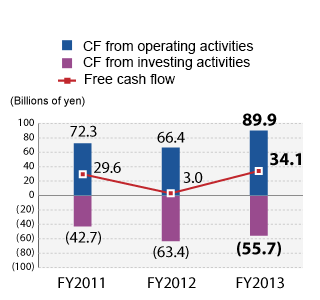
Cash Flows from Financing Activities
Net cash used in financing activities was ¥61.9 billion, compared ¥24.5 billion in the previous fiscal year. This mainly reflects an expenditure of ¥15.8 billion for the purchase of treasury stock, the payment of ¥9.2 billion in cash dividends, and a net decrease of ¥33.4 billion in short-term and long-term loans payable.
Total capital expenditure for the year ended March 31, 2014 came to ¥47.3 billion (excluding goodwill and intangible assets related to business combinations). Investment focused on the Group's core Business Technologies Business and Industrial Business, aimed mainly at support for new product development, increasing production capacity as well as streamlining and labor saving. Principal investments included machinery and equipment, tools and furniture, and molds for the Business Technologies Business, machinery and equipment for the Industrial Business, and buildings and R&D facilities for the Group.
All of these investments were paid for with cash on hand.
There was no significant sale, disposal or loss of facilities.
The Company recorded a ¥11.9 billion impairment loss on production facilities in the Industrial Business as a result of the withdrawal from the business of glass substrates for HDDs.
While capital investment increased, depreciation and amortization amounted to ¥47.3 billion.
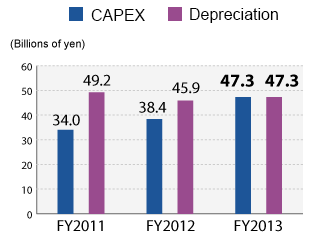
Research and development (R&D) expenses in the Business Technologies Business decreased ¥0.2 billion, or 0.7%, year on year to ¥39.0 billion. Expenses included development and commercialization of five models in the bizhub C554e MFP series, which can use data and documents stored on cloud services, in the office field, and of the bizhub PRESS C1070 series in print production.
R&D expenses in the Industrial Business decreased ¥0.6 billion, or 4.2%, year on year to ¥14.0 billion. Major factors included development of higher functionality, more diverse TAC films, such as protective films for the polarizers that are core components of LCD panels, as well as R&D for functional films and organic materials using materials technology. Furthermore, in industrial measuring instruments, we enhanced our lineup in the display measurement field.
R&D expenses in the Healthcare Business rose ¥1.1 billion, or 39.8%, year on year to ¥4.0 billion. We added the AeroDR 1012HQ, the world's lightest* cassette digital X-ray system, to the product lineup, and developed digital radiography systems and applications for various unit sizes.
As a result, total Group R&D costs edged down ¥0.3 billion, or 0.5% year on year to ¥71.1 billion. This figure includes basic research costs of ¥14.0 billion (down 4.0% year on year) not included in the individual segments.
- *
- At the time of its release
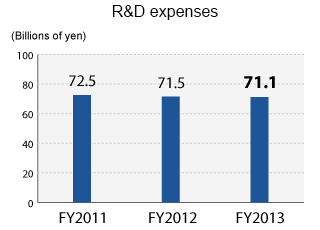
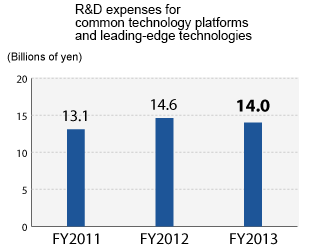
Assets
Total assets at March 31, 2014 were up ¥25.5 billion, or 2.7%, from the previous fiscal year-end to ¥966.0 billion. Current assets rose ¥9.7 billion, or 1.7%, to ¥589.3 billion (61.0% of total assets) while fixed assets rose ¥15.7 billion, or 4.4%, to ¥376.7 billion (39.0% of total assets).
With respect to current assets as of March 31, 2014, cash on hand and in banks increased ¥2.0 billion from the previous fiscal year-end to ¥95.4 billion, but short-term investment securities decreased ¥27.5 billion to ¥92.9 billion, and cash and cash equivalents decreased ¥25.4 billion to ¥188.4 billion. Meanwhile, notes and accounts receivable–trade increased ¥26.0 billion to ¥220.1 billion, and lease receivables and investment assets increased ¥5.2 billion to ¥21.2 billion. Inventories increased ¥2.7 billion to ¥115.2 billion.
In fixed assets, property, plant and equipment decreased ¥6.5 billion from the previous fiscal year-end to ¥173.3 billion due primarily to depreciation linked to the withdrawal from the business of glass substrates for HDDs, despite capital investment in the Business Technologies Business and Industrial Business as well as the construction of a new R&D building. Intangible fixed assets increased ¥0.4 billion to ¥111.3 billion.
In investments and other assets, investment securities increased ¥6.0 billion year on year to ¥29.2 billion as of March 31, 2014. Deferred tax assets increased ¥15.0 billion to ¥48.0 billion due primarily to a revision of recoverable amount in light of reorganization of the Group’s administrative structure conducted in April 2013.
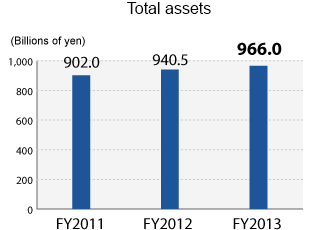
Liabilities
Total liabilities increased ¥11.8 billion, or 2.5%, year on year to ¥486.0 billion (equivalent to 50.3% of total assets). Notes and accounts payable–trade increased ¥10.8 billion to ¥96.2 billion and accounts payable–other and accrued expenses increased ¥12.8 billion to ¥74.3 billion. Provision for bonuses increased ¥2.1 billion. Net defined benefit liability increased ¥9.8 billion due to the application of accounting standards for retirement benefits. Interest-bearing debt (total of short-term and long-term debt and bonds) decreased ¥28.7 billion to ¥196.1 billion.
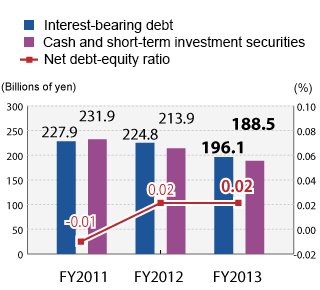
Net Assets
Net assets at March 31, 2014 were up ¥13.6 billion, or 2.9% from a year earlier to ¥480.0 billion (49.7% of total assets). Retained earnings increased ¥12.7 billion year on year to ¥242.4 billion, reflecting the ¥21.8 billion in net income for the period and cash dividends paid of ¥9.2 billion. Furthermore, treasury stock increased ¥15.7 billion due to repurchases. In accumulated other comprehensive income, foreign currency translation adjustments rose ¥23.3 billion due mainly to the continued weakness of the yen, mainly against the U.S. dollar and the euro, while the Company recorded negative remeasurements of defined benefit plans of ¥8.4 billion due to the application of accounting standards for retirement benefits.
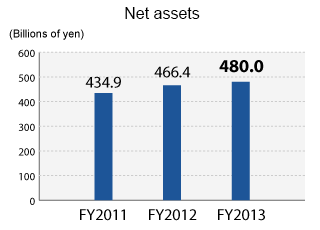
Bacic Dividend Policy
The Company's basic policy regarding the payment of dividends is to sustain distribution of earnings to shareholders after comprehensive consideration of factors including consolidated business results and strategic investment in growth areas. The Company's specific medium- to long-term dividend benchmark for dividends is a consolidated payout ratio of 25% or higher. The Company also considers factors such as financial position and share price in making decisions about share repurchases as another means of distributing earnings to shareholders.
Based on Article 459, Paragraph 1 of the Japanese Corporate Law, the Company's articles of incorporation specify the Board of Directors as the decision-making body with regard to the payment of dividends from retained earnings. The Company does not have a basic policy as to the number of times per year that dividends are paid, but, per the articles of incorporation, can pay dividends from retained income on March 31, September 30, and other record dates.
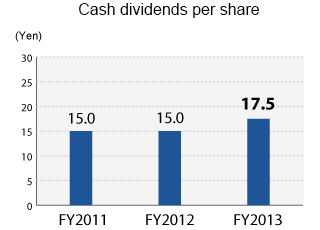
Dividends for the Fiscal Year Ended March 31, 2014 and
Planned Dividends for the Fiscal Year Ending March 31, 2015
With respect to dividends from retained earnings for the fiscal year under review, the Company will distribute a year-end dividend of ¥7.5 per share, as planned. Combined with the dividend of ¥10 per share paid at the end of the second quarter (comprising an ordinary dividend of ¥7.5 and commemorative dividend of ¥2.5), the total annual dividend will be ¥17.5 per share. The Company plans to increase annual dividends per share ¥2.5 to ¥20 for the fiscal year ending March 31, 2015.
Looking at the global economic conditions surrounding the Group, moderate economic recovery is expected in Europe while corporate results are projected to remain strong in the United States and Japan. Economies in emerging countries are forecast to keep expanding due to recovery in the economies of industrialized countries, despite lingering uncertainty in the Chinese economy.
As for the outlook for demand in the Group's main markets, in the Business Technologies Business, we expect demand for A3 color MFPs for the office to continue expanding in Europe and the United States. In emerging countries, demand for monochrome units and the overall market are projected to expand alongside economic growth. In the production print field, we expect sales of color units to expand and the number of units in the market to increase worldwide. In the Industrial Business, the market for notebook PCs is expected to continue contracting, while continued strong growth is forecast for smartphones and tablets, and the TV market is projected to expand moderately as well. In addition, as the use of smartphones and tablets spreads, displays for mobile devices are expected to increase in volume terms and capital investment is forecast to increase in the manufacturing sector. In digital cameras, the market for compact cameras is expected to continue contracting due to smartphone growth, while sales of models with interchangeable lenses are projected to remain firm. In the Healthcare Business, robust growth is forecast for cassette digital x-ray systems in all regions.
Cash dividends per share ¥20.00
We assume exchange rates of JPY 100 to USD 1 and JPY 135 to EUR 1.
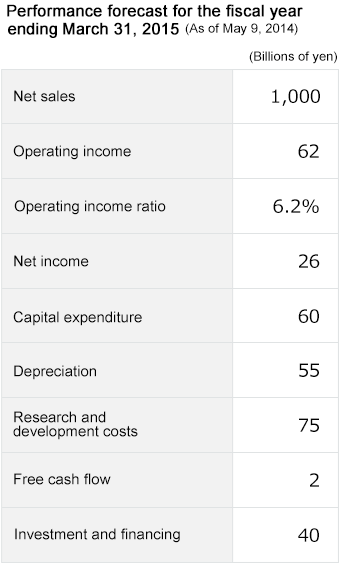
Business Risks
Of the business operations and accounting status described in the Group's Securities Report, the following risks could have a significant effect on the judgment of investors in the Group. Further, the forward-looking statements in the following section are the Group's judgments as of June 20, 2014.
Risks Relating to the Economic Environment
(1) Economic Developments in Major Markets
The Group supplied MFPs, production printing systems, image input/output components and display materials, healthcare equipment and related services, and other products and services to customers around the world. Sales and profits in these business segments are strongly affected by economic developments in individual national markets.
Ongoing concerns in the global economy include anxiety over the relapse of fiscal problems in Europe, a slowdown of growth in the Chinese and other emerging economies, and monetary policy revisions in leading countries. Economic slumps in various countries have resulted in curtailment of investment by customers, reduction of expenditures, and sluggish consumption. Consequently, higher inventories and intensifying competition are pushing down prices, and lower sales volumes and other factors may have an adverse impact on the Company’s business performance and financial position.
(2) Fluctuations in Exchange Rates
As indicated by the high percentage of overseas sales (77.4% in FY 2013), the Group engages in business globally and is susceptible to substantial impacts from changes in exchange rates. To reduce these effects, the Group engages in hedging with a focus on forward contracts for major currencies such as the US dollar and the euro.
In the Business Technologies Business, MFPs, printers and production printing systems produced in China are procured on a US dollar basis, and consequently, sales in regions where sales are conducted in US dollars including the United States are largely offset by purchases, and this has the effect of reducing the impact of changes in exchange rates. With respect to the euro, however, changes in exchange rates have a direct impact on profits. An increase in the value of the yen against the US dollar and the euro has an adverse impact on the Group’s results and a decrease in the value of the yen has a positive impact.
Risks Relating to the Industry and Business Operations
(3) Competition in Technological Innovation
In the Business Technologies Business including MFP, printers, and production printing systems, the Group’s major business fields including TAC film for LCD polarizers, and new business fields that the Group should develop in the future such as Organic Light Emitting Diode (OLED) lighting, technological innovation that precedes other companies is an important source of competitive superiority.
The Group continuously undertakes the challenges of development of innovative technologies and actively invests in R&D and makes capital investment for this purpose, but it is possible that the Group will not be able to provide such technologies in a timely manner. It is also possible that competitors will release similar technologies or alternative technologies before the Group. It is crucial that the Group accurately monitor developments in innovative technologies to respond to customer needs, but if the group is unable to develop such technologies, it may lose competitiveness in key and new business segments.
(4) Business Environment in the Equipment and Services Business Segments
Demand is rising for high added-value products that incorporate network support and multifunction capabilities in the office equipment industry including MFPs, printers, and production printing systems as well as in the healthcare equipment segment, and demand for solutions and services is also rising. In the office equipment industry in particular, the companies are conducting acquisitions and reorganization and forming alliances with IT firms to reinforce their sales channels. Competition among manufacturers that take action in response to this trend involving logistics within the industry is expected to intensify.
In the Business Technologies Business, which drives Group growth as its largest segment, the Group adopted the Genre-top strategy, for focusing management resources on expanding the business for color MFPs for office use and production printing systems in advance of other companies and joined the ranks of the industry-leading group in the European and American markets. The pace of technological innovation in this area is high, however, and as the importance of solutions and services increases, there is no guarantee that the Group’s technological superiority can be maintained. If the competitiveness of technology and sales channels is this segment cannot be maintained and business growth slows, the Group’s business results may be adversely affected.
Furthermore, the trend towards reducing installations of new MFPs as a result of curtailed corporate investment and cost cutting could also have an adverse impact on the Group’s business results in the future.
(5) Business Environment in the Industrial Business
In the digital consumer electronics market including LCD televisions, DVDs and digital cameras for which the Industrial Business provides components and materials, the trend for manufacturers to lower market prices in the midst of fierce competition is ongoing, and the effects extend to component and material manufacturers including the Company. As product lifecycles become shorter, there is also a growing tendency for companies to quickly market products manufactured in large quantities, and as a result of market competition, rapid and extreme fluctuations in supply and demand in conjunction with production adjustments could have an adverse impact on the Group’s business results.
In addition, the Group’s main customers in its Industrial Business are digital consumer electronics manufacturers, and in addition to the effects of rapid changes in demand and falling prices, if the Group’s responses to industry developments including global reorganization within the digital consumer electronics industry and next-generation products are inadequate, it may lose its customers, which could have an adverse impact on its business performance.
(6) Quality Issues
The Group has established rigorous quality control systems within domestic and overseas Group Companies and supplies high-quality, high-reliability products and services to its customers. If a defect in a Group product or service were to occur, the Group may be liable to pay compensation for the damage caused by the defect. Also, substantial expenditures may be required to remedy the defect. Furthermore, reports of the defect in the media may have an adverse impact on the Group’s business and reputation.
(7) Global Business Operations
A substantial portion of the Group’s business operations are conducted in countries outside of Japan, in North America, Europe, and Asia.
Engaging in this type of global corporate operations entails the following types of risks.
- Changes in exchange rates
- Political instability and uncertainty concerning economic developments
- Unforeseeable changes in laws, regulations, and tax systems
- Difficulty recruiting and maintaining employment of highly skilled human resources
- Weakness of industrial infrastructure
The Group has positioned the expansion of business in overseas markets as a priority issue, but if the Group is unable to respond adequately to these types of risk unique to global business operations, there could be an adverse impact on the Group’s business results and growth strategies. In the Business Technologies Business and Industrial Business, which are the Group’s leading business segments, priority is placed on expanding production in China as a means of enhancing cost competitiveness. In the Business Technologies Business, the Group has established production sites in Dongguan and Wuxi, where most MFPs, printers and production printing systems sold throughout the world are produced and shipped. In addition, the Industrial Business has production sites in Dalian and Shanghai, where image input/output components and other products are manufactured. In conjunction with economic development in China, legal reforms and infrastructure development are also advancing, but various circumstances that may be difficult to foresee may arise such as legal changes, stringent labor policies, rising labor costs, devaluation of the yuan, and changes in import/export restrictions and tax systems. For the Group, which relies on China for a substantial portion of production in its core business segments, the inability to respond to these risks could have an adverse impact on the Group’s business results and growth strategies.
(8) Securing Human Resources
The sources of the Group’s growth are supported by skilled human resources. Securing the excellent engineers and highly skilled technical personnel who will make the advances in the Group’s core technologies in fields such as optical products, materials, nano-fabrication, and imaging will be increasingly important for maintaining the Group’s high competitiveness in the future. Moreover, as the business world becomes ever more digital and networked, reinforcing capabilities in information and communications technology fields such as software and control is a pressing issue for the Group to remain competitive, and this will require recruiting of outstanding technical personnel and system engineers.
In addition to these technology fields, it is also becoming more important for the Group to recruit marketing and sales personnel to develop new sources of revenue in areas such as solutions and services. Amongst strong demand, however, companies are facing intense competition to secure such capable human resources. If the Group is unable to recruit and retain such highly skilled personnel, there could be an adverse impact on the implementation of the Group’s growth strategies.
(9) Alliances with Other Companies and Strategic Investment
The Group engages in collaboration with other companies including technology alliances, business alliances, and joint ventures from the perspectives of enhancing business competitiveness and raising efficiency.
In the Business Technologies Business, the Group has aggressively promoted M&A to expand sales of output units, chiefly MFPs, and business solution services to transform the nature of its business in the future. In Europe, the Group formed a capital and business alliance with France-based MGI Digital Graphic Technology S.A., which operates a unique business in such growth markets as plastic cards. This alliance is aimed at developing applications for package printing, in addition to paper output in the existing commercial printing market. In the Healthcare Business, efforts are now underway to make a full scale entry into the field of ultrasound diagnostic imaging equipment, which has been positioned as a new growth driver, by utilizing the resources gained following the transfer of the business from Panasonic Healthcare Co., Ltd. The Group considers further alliances with other companies and acquisitions as an option for future growth strategies.
(10) Rising Raw Material Prices and Energy Costs
A rapid increase in the prices of raw materials used in the Group’s production such as iron, and aluminum and petrochemical materials made from crude oil, scarce natural resources such as rare earth minerals as well as higher costs for energy could have an adverse impact on the Group’s business results.
The Group is responding to these rises in materials prices by taking measures to reduce costs and by shifting the higher costs into product prices (i.e., raising prices), but there is no guarantee that the higher costs can be completely covered, and higher sales prices entail the risk of declining sales volumes.
(11) Procurement of Raw Materials, Resources and Energy
The Group procures specific products, components, materials and energy from external suppliers. If unforeseeable circumstances occur in relation to those suppliers, there could be an adverse impact on the Group’s production and supply capabilities.
Risks Relating to Legal Systems and Litigation
(12) Intellectual Property Rights
To maintain its superiority in business competitiveness, the Group is accumulating extensive differentiation technologies and know-how from its product development activities and takes measures to protect its intellectual property rights. If, however, the Group is unable to protect its intellectual property assets because of legal restrictions in some regions, the Group may be unable to prevent third parties from using its intellectual property assets to manufacture and sell similar products.
In addition, the Group conducts product development in a manner to avoid infringement of the rights of other companies, but there is a possibility that the Group will be accused of infringing on the intellectual property rights of other companies as a result of differences of opinion or other factors and consequently will not be able to use technologies that are important to its business or that it will be liable to pay substantial compensatory damages.
There is also a possibility that the use of third-party intellectual property rights for which the Group has obtained licenses will be suspended in the future or that inappropriate terms of use will be imposed.
(13) Healthcare Systems
The Group’s Healthcare Business is affected by the diverse healthcare systems and licensing procedures in the countries where it conducts business. Reform of healthcare systems and other factors may lead to large-scale unforeseeable changes in healthcare administrative policies, and if the Group is unable to respond promptly to those changes in the business environment, this could have an adverse impact on the Group’s business results.
(14) Environmental Regulations
The Group is subject to various environmental laws and regulations concerning atmospheric pollution, water contamination, elimination of hazardous substances, disposal of waste, product recycling, soil and ground water contamination, and so on, and there is a risk of the Group incurring expenses or liability to pay compensation in conjunction with environmental responsibility for current or past business production operations. In addition, if environmental regulations become even more stringent in the future, there is a risk that the Group will need to perform additional work and incur expenses to ensure compliance, and this may have an adverse impact on the Group’s business results.
(15) Information Leaks
Through its diverse business activities, the Group acquires personal and confidential information relating to its customers and business partners. The Group has established internal systems, conducts employee training, and takes other measures relating to the management of this information, but there is a possibility of external leaks resulting from unforeseen circumstances. If an information leak occurs, persons harmed by the leak may demand compensatory damages, and there is a possibility of an adverse impact on the Group’s reputation and image. In addition, if confidential information relating to the Group’s technologies, contracts, or personnel is leaked, there could be an adverse impact on the Group’s business results.
Disasters and Other Risks
(16) Effects from Disasters
The Group engages in global business operations through R&D, procurement, production and sales sites in numerous countries around the world. In the event of an earthquake, fire, hurricane, flood, other natural disaster, pandemic such as a new strain of influenza, war, act of terrorism, or attacks by a computer virus, the Group’s facilities may be damaged, and it may be forced to temporarily suspend operations, resulting in delays of production and shipments. These and similar events could also disrupt or restrict use of essential utilities such as electricity, gas and water; cause supply shortages of components and raw materials by disrupting supply chains; halt distribution; or disrupt markets. Such circumstances may lead to sales falling below planned levels, and substantial costs may be incurred to restore damaged facilities, which could have an adverse impact on the Group’s business results.
(17) Impairment of Long-Lived Assets
The Group began applying accounting standards relating to impairment of long-lived assets such as property, plant and equipment and goodwill in the fiscal year ended March 31, 2006. With regard to amounts for long-term assets reported on consolidated balance sheets, recoverable amount of residual value from future cash flows generated by those assets are periodically assessed, but if business profitability declines as a result of competition or other factors and those assets are not able to generate adequate cash flows, it may be necessary to recognize additional impairment, and this could have an adverse impact on the Group’s business results.




